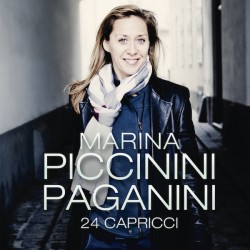Paganini’s 24 Violin Caprices have been attracting flute virtuosos on disc, each approaching the original text’s idiomatic challenges in a different way. For example, Patrick Gallois’ arrangements employ a myriad of 20th-century flute techniques like circular breathing, flutter tonguing, and humming into the instrument. By contrast, Bonita Boyd recorded 19th-century flutist Julius Herman’s transcriptions, which adhere more closely to the era’s performance practices yet are based on heavily edited texts that are not always accurate.
Marina Piccinini’s edition is based on Paganini’s Urtext, and is similarly conservative from the standpoint of flute technique. She also contends that normal breathing allows the ebb and flow of Paganini’s phrasings to emerge more naturally. Collectors may be taken aback at her total timing of more than 100 minutes for a work that usually requires 72 minutes. This has less to do with tempos (which are not unusually slow) as it does with the flutist’s small fluctuations in pulse, agogic stresses, tenutos, accentuations, and other expressive gestures. Furthermore, Piccinini’s softer-grained articulation and tendency to shape phrases in asymmetrical note groupings radically differ from Boyd’s rhythmic drive and technical ebullience, yielding a high degree of textural diversity and harmonic tension.
To give several examples, Boyd plays No. 12’s persistent “string crossing” patterns in a relatively firm tempo, while Piccinini is more italicized and nuanced. At first Piccinini seems to play No. 9’s main theme in an understated, slightly diffident manner at far remove from Boyd’s surface sparkle. However, this helps to provide more contrast to the inherent urgency in the “question and answer” scale passages in the minor-key middle section. Boyd’s amazingly agile handling of No. 22’s long sustained tones and rapid chromatic runs is nothing less than a great virtuoso feat. Piccinini matches this achievement note for note, but through subtler scaling of dynamics and greater variety of accent. She also invests No. 19’s grace note octave leaps with more meaningful deliberation and plays up the timbral differences between higher and lower registers rather than aiming for a seamless blend.
While some listeners may find Boyd’s Paganini more incisive and direct, Piccinini’s intelligent musicality and command manage to reveal these familiar works in a new, thought-provoking light that transcends the question of instrument.
































